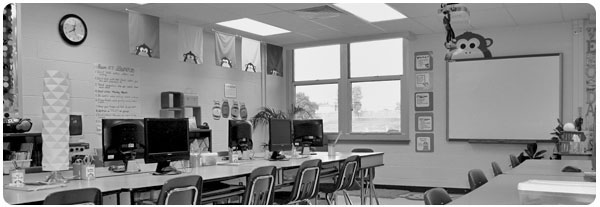

| I believe that technology is a tool that enhances an inquiry based learning environment. | |
Throughout my training as an eMINTS teacher and my coursework toward my specialist degree, I have transformed my classroom into a place where students are knowledge seekers who delve deeply into subjects led by essential questions. I no longer take for granted that my students will get what they need from a textbook. Instead, I rely on extensive backward design unit planning to include use of the computer, internet, SMARTboard, scanner, and digital camera. These technological tools integrate to lead my students along different avenues to explore and learn in ways not possible without technology. “Technology can engage children in the curriculum when they may otherwise be disinterested or apathetic,” (VanderVeen 2006). Through the use of my classroom Moodle, students are exploring and questioning each other while I facilitate their learning. I encourage my students to develop their own interests and questions, then utilize the research tools available to explore topics and answer their own questions along the way. "When students are given opportunities to investigate relevant, interesting phenomena and use the information their gather to solve problems, answer their questions, or inform others, they engage in learning that has significance and value," (Jonassen 2008). I believe that technology plays an essential role in the success of my inquiry based classroom.
|
|
| I believe that technology helps to make learning accessible for all students. | |
Whether a student is gifted, has a learning disability, a physical disability, or a combination, technology is a tool that can aid in their success. Technology means success for all students. "Many modifications and options built into applications for learners with disabilities can be helpful to other students as well. A one-size-fits-all model is not effective for students with varied ways of receiving, processing, and expressing information." (Brodey 2006). Every student enjoys having a chance to shine and be successful in the classroom. Hardware, software, and unit planning can integrate to create meaningful lessons and learning experiences to engage all students. Programs like Inspiration and websites like Read, Write, Think can be used to foster writing development and create connections that may not be apparent without technology. Blogging can be used to develop projects to engage all learners. "Where in the World is Mrs. V?" is a project that students enjoy getting involved in, researching for, and working toward the goal of solving the mystery. "Gifted students can work at their own pace and explore subjects in more depth than the basic curriculum.” (Kelley and Ringstaff, 2002) Students have the tools to take learning to a new level. The internet and software work cohesively to provide a vehicle for students to take their learning to higher levels and differentiation becomes far more possible. In WebQuests that I have created, such 1904 World's Fair, students are engaging with curriculum and achieving goals at their own levels. Technology allows all types of learners to achieve. With more chances for project-based learning, and performance event assessments that incorporate the tools of technology, students get the chance to work at their own level, collaborate, and develop. Questioning, research, creating, and designing are possible for all students and the meaningful use of technology ensures this.
|
|
| I believe that technology promotes collaboration and higher level thinking skills | |
| When my classroom is bustling with activity, students are collaborating and creating with technology and I am facilitating their learning. I realize that technology plays a very important role in the success of this environment. Projects like podcasting, digital storytelling and WebQuests create situations where students must take responsibility in their learning and share with others to create the finished product. In the World's Fair WebQuest that I created, students were required to collaborate to create a broadcast "live" from the fair. This was not a simple fill in the blank assignment, but rather an engaging, high-interest task that led students to the highest levels of thinking. It required them to take the facts of history that they gathered and synthesize them into a project to present to other fourth graders. Projects incorporating technology require students to think, create, design, and develop their work on the highest levels of Bloom's Taxonomy. Projects in the "Transforming" level of Grappling's Learning and Technology Spectrum aim to help students create new ways of telling information. When I see my students gathered around the SMARTBoard or sharing their computer in collaboration, I know they are working together, learning from each other, and thinking at the highest levels. | |
 |
|
| References | |
Brodey, Jessica. (2006). Using Technology to Raise Achievement for ALL Students Retrieved March 11, 2008, from Accessible Technologies for All Students Quarterly. Website: http://www.accessibletech4all.org/publications/summer2006.html Jonasssen, David. (2008). Meaningful Learning with Technology. New Jersey: Pearson Prentice Hall. Kelley, L., C. Ringstaff (2002). The learning return on our educational technology investment. San Francisco, CA: WestEd. VanderVeen, C. (2006). Wired Generation. Wisconsin Journal of Technology. 12, 12-14. |
|